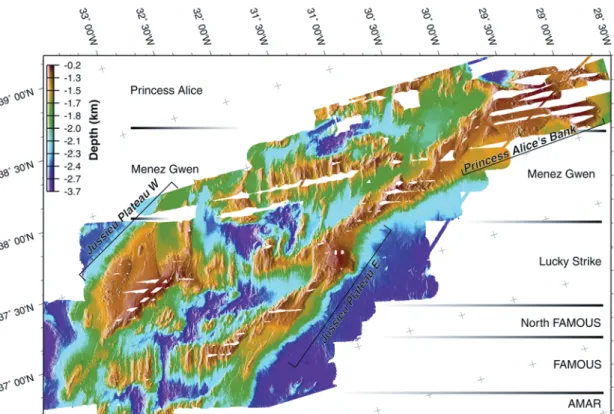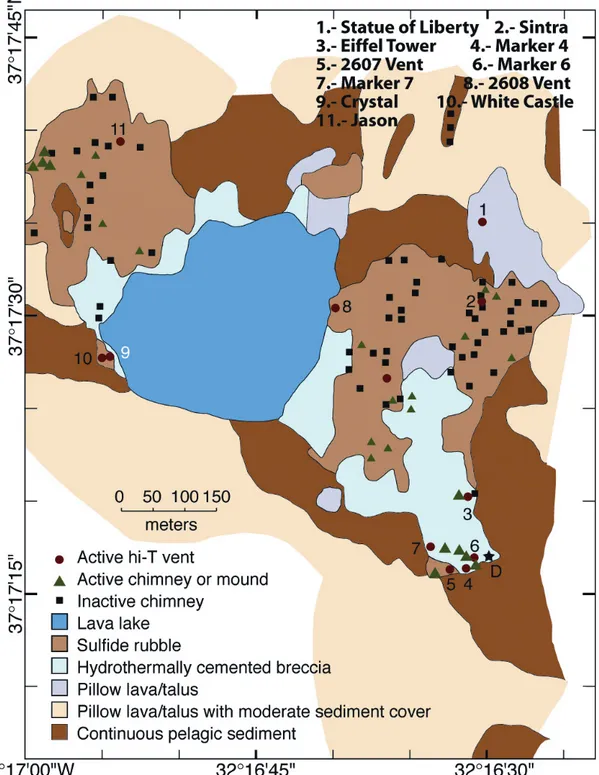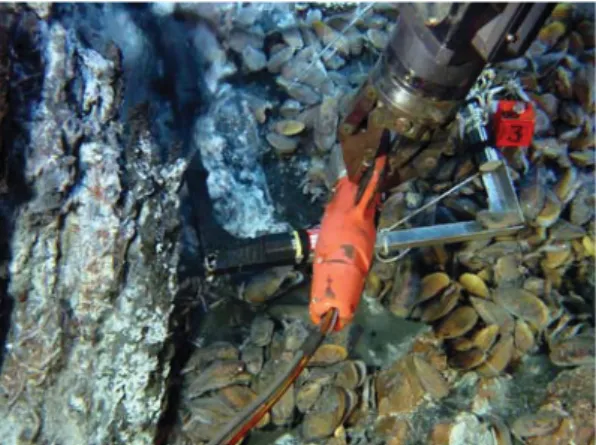Ricardo Serrão Santos, Javier Escartín, Ana Colaço
& Agnieszka Adamczewska
(Eds)
Arquipélago - Life and Marine Science
Supplement 3
ARQUIPÉLAGO
Life and Marine Sciences. Bulletin of the University of the Azores.
PUBLISHER
University of the Azores, Rua Mãe de Deus, 58 PT - 9501-801 Ponta Delgada, Azores, Portugal.
GUEST EDITORS FOR SUPPLEMENT 3
Ricardo Serrão Santos, Javier Escartín, Ana Colaço & Agnieszka Adamczewska
INFORMATION ON THE INTERNET
Abstracts of all papers as well as instructions to authors are available on the Internet at: http://www.horta.uac.pt/editions/arquipelago.html
EDITORIAL SECRETARIAT
Helen Rost Martins, João M. Gonçalves, Rogério R. Ferraz, Horta.
COVER PICTURE
Composition by RR Ferraz - ImagDOP using © IFREMER photographs
Indexed in:
Aquatic Sciences and Fisheries Abstracts (ASFA), BIOSIS, Current Awareness in Biological Sciences
(CABS), Marine Science Content Tables (MSCT), Zoological Record
For purpose of citation, this supplement should be cited as follows:
R.S.SANTOS,J.ESCARTÍN,A.COLAÇO &A.ADAMCZEWSKA (Eds). 2002. Towards planning of seafloor observatory programs for the MAR region (Proceedings of the II MoMAR Workshop). Arquipélago. Life and Marine Sciences. Supplement 3: XII + 64 pp.
InterRidge
Monitoring and Observatories Working Group
W
ORKING GROUP MEMBERS:
C
ONVENERS:
Ricardo Serrão Santos (DOP, University of
Azores, Portugal)
Javier Escartín (co-chair)
France
Ricardo Serrão Santos (co-chair) Portugal
Javier Escartín (IPGP/CNRS, France)
Christopher
Fox
USA
A
SSOCIATED CONVENERKyohiko Mitsuzawa
Japan
Ana Colaço (DOP, University of the Azores,
Portugal)
Pierre-Marie Sarradin
France
Adam
Schultz
UK
I
NTERR
IDGEC
OORDINATORPaul
Snelgrove
USA
Agnieszka Adamczewska (InterRidge,
ORGANISATION:
INDEX
WORKSHOP PROGRAM xi
EXECUTIVE SUMMARY 1
1. WORKING GROUPS: RECOMMENDATIONS AND RESULTS 2
1.1. INTRODUCTION 2
1.2. BIOLOGY WORKING GROUP 2
1.3. EARTH SCIENCES WORKING GROUP 4
1.4. LUCKY STRIKE WORKING GROUP 5
1.5. MENEZ GWEN,RAINBOW, AND LARGER MOMARAREA WORKING GROUP 8 Introduction - Why study several hydrothermal sites? 8
Part 1 - Rainbow to Menez Gwen area: Work to be done on existing sites 8 Part 2 – Additional Hydrothermal Explorations 10
1.6. DATA MANAGEMENT WORKING GROUP 12
1.6.1. Preparation of projects and implementation of MoMAR 13 1.6.2. Data generated in the context of MoMAR 14 1.6.3. Hosting and coordination of data, information, etc. 15 1.6.4. Data dissemination and outreach 15
1.7. MOMARSITE MANAGEMENT WORKING GROUP 15
1.7.1. Important policy issues 15
Site Management Committee mandate: 16
1.7.2. Planning and organization of the MoMAR project 16 1.7.3. MoMAR: Integration and outreach 16 1.7.4. Requirements and responsibilities of PIs 16
1.7.5. MoMAR Committee structure 17
1.8. TECHNOLOGY DEVELOPMENT WORKING GROUP 17
1.9. FOLLOW-UP OF MOMAR 18
1.9.1ROLE OF MOMAR 18
1.9.2MOMAR COMMITTEE 19
APPENDIX I - WORKING PAPERS 20
Biological aspects working paper: How to study the ecosystem dynamics at a decadal scale? 21 The ichthyology of the MAR hydrothermal vents and the MoMAR initiative 26
APPENDIX II - LIST OF PARTICIPANTS 27
APPENDIX III - POSTER ABSTRACTS 32
V.BALLU et al.: The GRAVILUCK project in the MoMAR framework 33
S.BAZIN et al.: Deployment of new hydrophone array north of the Azores for seismic monitoring of the
ridge and the Azores Plateau
34 A.CHECA: On the model of periostracum and shell formation in Unionidae (Mollusca: Bivalvia) 35
A.COLAÇO et al.: LABHORTA - a land-based laboratory for vent studies 36
R. COMPANY et al.: Antioxidant defence mechanisms in the hydrothermal vent mussel Bathymodiolus azoricus from the Mid-Atlantic Ridge hydrothermal systems
37 W.CRAWFORD et al.: SISMOMAR: seismic structure of Lucky Strike area 38 D.DIXON et al.: Acoustically retrievable cages open up deep-sea vents to time-series studies 39
R.DZIAK et al.: Analysis of P- and T-wave arrivals recorded by a moored hydrophone array along the
Mid-Atlantic Ridge (10°-35°N) 40
P.EINARSSON: Seismic expression of processes associated with the divergent plate boundary in Iceland 42 H.FELICIA et al.: Methallothionein levels in fish from Lucky Strike hydrothermal vent 43
Towards planning of seafloor observatory programs for the MAR region
J.GASPAR et al.: SUMMO/AÇORES. Unified system for the geophysical monitoring and modelling of the
Azores Region 46
C.GERMAN: Monitoring hydrothermal activity on the Mid-Atlantic Ridge 48 D.HASSLER: RIDGE 2000 begins a new decade of mid ocean ridge research and the RIDGE 2000 steering
committee
49 N.LOURENÇO et al.: A tectonic model for the generation of the Saldanha massif 51
I.MARTINS et al.: Mercury levels in organisms from hydrothermal vents 52
L.MATIAS et al.: MASHA multi-scale approach for seismovulcanic hazard in the Azores 54
N.MESTRE et al.: Distribution and temporal evolution of macrofauna in a hydrothermal edifice – Eiffel
Tower, in the Lucky Strike Hydrothermal Vent Field on the Mid-Atlantic Ridge
56 G.MOURA et al.: An overview on nacre formation in the freshwater clam, Anodonta cygnea (L.) (Mollusca:
Bivalvia)
57 E.NIEUKIRK et al.: Alternate scientific applications of hydrophone arrays deployed at MoMAR 58
RAMIREZ-LLODRA et al.: The ChEss Programme: Biogeography of Chemosynthetic Ecosystems for the
Census of Marine Life 59
S.SICHEL et al.: Constraints on the existence of a subduction plate beneath the equatorial Atlantic 60 P.SILVA et al.: Magnetic properties from Saldanha Massif basalts 61
G.SILVEIRA et al.: Coordinated seismic experiment in the Azores (COSEA) 62
APPENDIX IV – RELATED DOCUMENTS 63
A.1 Expression of Intention to the EU (VI FP) - Integrated Project MoMAR 63 A.2 Expression of Intention to the EU (VI FP) - Network of Excellence EURECO 64




